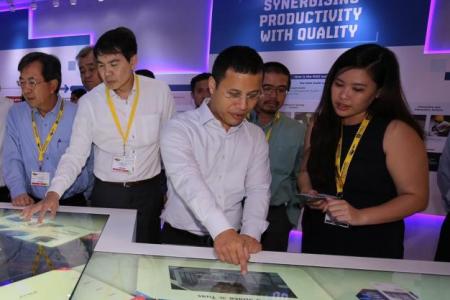Wooing Singaporeans to the construction industry
BCA aims to have 80,000 personnel trained in construction technology, which prioritises innovation
Singaporeans joining the construction industry in the near future may be greeted with digital design and cutting-edge technologies as the Government embarks on an overhaul of a sector that has long struggled to attract local workers.
"We are speaking about transformation of the whole construction sector - the entire process and value chain, from end to end," Second Minister for National Development Desmond Lee said at the opening of the Singapore Construction Productivity Week yesterday.
The Building and Construction Authority (BCA) is aiming to have 80,000 personnel trained in construction technology - which prioritises productivity and innovation over manual work - enter the industry by 2025. There are currently 32,600 trained in these areas.
The move is part of the newly launched Construction Industry Transformation Map (ITM), which is designed to pave the way for more attractive and highly skilled jobs in the sector.
The move will also mean holding steady the figure of nearly 300,000 foreign workers the sector now relies on.
BCA chief executive officer Hugh Lim said: "We want to try to maintain the number of foreign workers at the current level, yet be able to cope with an increase in output as more big projects start kicking in."
BCA started to explore the feasibility of using new construction paradigms, such as Design for Manufacturing and Assembly (DfMA), a decade ago to boost productivity rates and change the industry into one that resembles a highly productive manufacturing line.
This is achieved through technology such as prefabricated prefinished volumetric construction (PPVC), where large building modules manufactured in factories are assembled in a Lego-like manner. This way, construction sites can see up to 40 per cent of manpower savings, which could mean faster completion times, fewer incidents and a cleaner site.
BCA targets 40 per cent of all projects to adopt DfMA by 2020, up from the 10 per cent now.
For HDB flats, 35 per cent of dwelling units will use concrete PPVC by 2019, making the Housing Board one of the biggest adopters of the technology.
The ITM also charts the adoption of other high-tech methods in the construction pipeline, including a move to integrate designers, builders, subcontractors and facility managers in the building's life cycle through an approach known as Integrated Digital Delivery (IDD).
Operations and maintenance of a building can cost up to five times more than construction, so with IDD, potential life cycle savings will be considerable.
Out of the 80,000 people to enter the industry, 35,000 will be trained in DfMA, 20,000 in IDD and 25,000 in green building technologies.
These high-tech methods are still more expensive, putting small and medium-sized enterprises (SME) at a disadvantage when it comes to early adoption. Reactions were mostly positive, but a few SMEs had qualms.
Business development manager Lim Wei Chian of Tong Hai Yang Construction said: "It will take time for everyone to familiarise themselves with it, but we will get there."
FOR MORE, READ THE STRAITS TIMES TODAY
Building on innovation
Build a higher-skilled workforce focused on digital technologies:
- To attract IT-savvy Singaporeans, jobs will involve higher skills training in construction technologies and will offer more competitive salaries and a better work environment.
- More structured internships and a comprehensive training pathway for people to pick up new technologies will be developed by a task force comprising BCA, institutes of higher learning and industry associations.
Increase the use of more productive construction methods:
- Design for Manufacturing and Assembly - a highly productive method of construction that moves on-site work into off-site environments - should see 40 per cent adoption in all projects by 2020.
- Construction processes are digitised through Building Information Modelling, which allows stakeholders to collaborate from an early stage. This has been progressively mandated for certain projects. BCA will develop standards to ensure interoperability of the Integrated Digital Delivery system, which integrates designers, builders, subcontractors and facility managers in the building's life cycle.
Build progressive and collaborative firms:
- The Government will review public procurement practices to place higher weighting on non-price components such as productivity and quality scores. A working committee will be set up to look at collaborative contracting models to facilitate greater cooperation among firms.
- THE STRAITS TIMES
Get The New Paper on your phone with the free TNP app. Download from the Apple App Store or Google Play Store now


